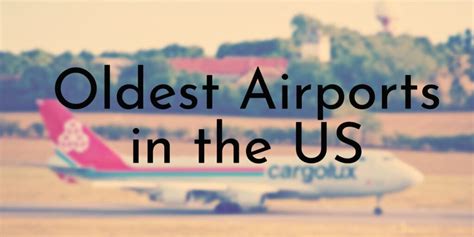Oldest Airports In The United States

The history of aviation in the United States is a rich and fascinating one, with numerous airports playing a significant role in shaping the country's transportation landscape. As we explore the oldest airports in the United States, we'll delve into the early days of flight, the pioneers who paved the way, and the evolution of these airports over time. From humble beginnings to modern-day hubs, these airports have witnessed the growth of commercial aviation, technological advancements, and the ever-changing needs of travelers.
Established in 1909, College Park Airport in Maryland is often credited as the oldest continuously operating airport in the United States. Initially used for military and civilian training, it has since become a popular destination for aviation enthusiasts and history buffs. The airport's proximity to Washington, D.C. made it an ideal location for early aviators, including the Wright brothers, who conducted flight experiments and training sessions there. With its rich history and significance, College Park Airport has been recognized as a National Historic Landmark since 2008.
Key Points
- College Park Airport is the oldest continuously operating airport in the United States, established in 1909.
- The airport has played a significant role in the development of aviation, with notable figures like the Wright brothers conducting flight experiments and training sessions there.
- Other notable airports, such as Boston's Logan International Airport and Chicago's Midway International Airport, have also been in operation for nearly a century.
- The evolution of airports has been shaped by advances in technology, changes in consumer demand, and the need for increased security measures.
- Today, these historic airports continue to serve as important transportation hubs, connecting people and goods across the country and around the world.
Early Aviation and the Development of Airports
The early 20th century saw a surge in aviation activity, with numerous airfields and airports springing up across the United States. One of the most notable airports from this era is Boston’s Logan International Airport, which began operations in 1923. Originally known as Boston Airport, it was renamed in 1943 in honor of General Edward Lawrence Logan, a Boston native and Spanish-American War veteran. Logan Airport has since become one of the busiest airports in the country, serving as a major hub for domestic and international flights.
The Golden Age of Aviation
The 1920s to the 1940s are often referred to as the “Golden Age” of aviation, with airports like Chicago’s Midway International Airport (established in 1927) and Los Angeles International Airport (established in 1928) becoming major centers for commercial aviation. During this period, airports began to expand their facilities, introducing new technologies and amenities to accommodate the growing demand for air travel. The construction of terminals, hangars, and runways enabled airports to handle larger aircraft and increasing passenger traffic, paving the way for the modern air travel experience.
| Airport | Established | Original Name |
|---|---|---|
| College Park Airport | 1909 | None |
| Boston Logan International Airport | 1923 | Boston Airport |
| Chicago Midway International Airport | 1927 | Chicago Municipal Airport |
| Los Angeles International Airport | 1928 | Mines Field |

Evolution and Modernization

Over the years, these historic airports have undergone significant transformations to accommodate growing demand, advances in technology, and shifting consumer expectations. The introduction of commercial jet aircraft in the 1950s, for example, led to the construction of longer runways and more modern terminals. The 1970s saw the introduction of airport security measures, while the 1990s and 2000s brought about significant investments in airport infrastructure, including the development of new terminals, concourses, and transportation systems.
Challenges and Opportunities
Despite the many challenges faced by the aviation industry, including security concerns, environmental impact, and economic fluctuations, these historic airports continue to thrive. By embracing innovation, investing in sustainable practices, and prioritizing passenger experience, airports like College Park, Logan, Midway, and LAX remain vital components of the national transportation network. As the industry looks to the future, it’s likely that these airports will continue to play a significant role in shaping the evolution of air travel, with a focus on sustainability, technology, and customer satisfaction.
What is the oldest continuously operating airport in the United States?
+College Park Airport in Maryland, established in 1909, is the oldest continuously operating airport in the United States.
How have airports evolved over time to meet changing demands and technological advancements?
+Airports have undergone significant transformations to accommodate growing demand, advances in technology, and shifting consumer expectations. This includes the introduction of commercial jet aircraft, airport security measures, and investments in airport infrastructure, such as new terminals, concourses, and transportation systems.
What role do historic airports play in the modern aviation industry?
+Historic airports like College Park, Logan, Midway, and LAX continue to serve as vital transportation hubs, connecting people and goods across the country and around the world. They have adapted to changing times, embracing new technologies and innovations to meet the evolving needs of travelers.
In conclusion, the oldest airports in the United States have played a significant role in shaping the country’s aviation history. From humble beginnings to modern-day hubs, these airports have evolved to meet changing demands, technological advancements, and shifting consumer expectations. As the industry continues to grow and evolve, it’s likely that these historic airports will remain vital components of the national transportation network, connecting people and goods across the country and around the world.



